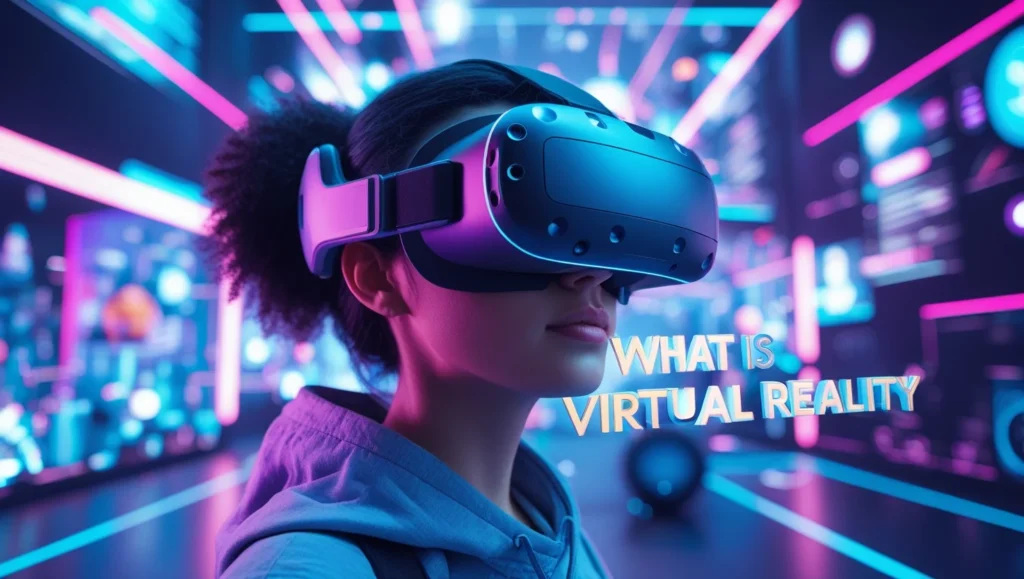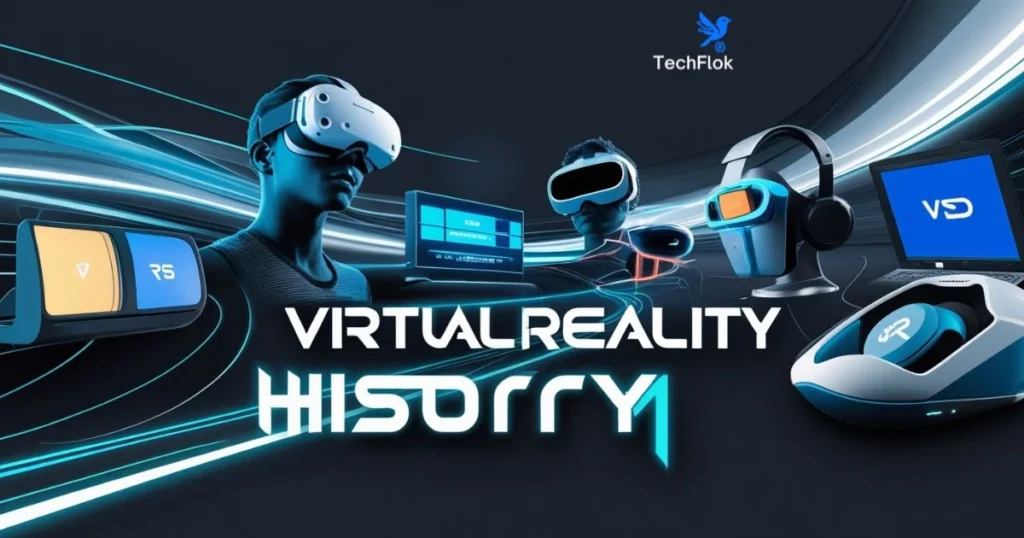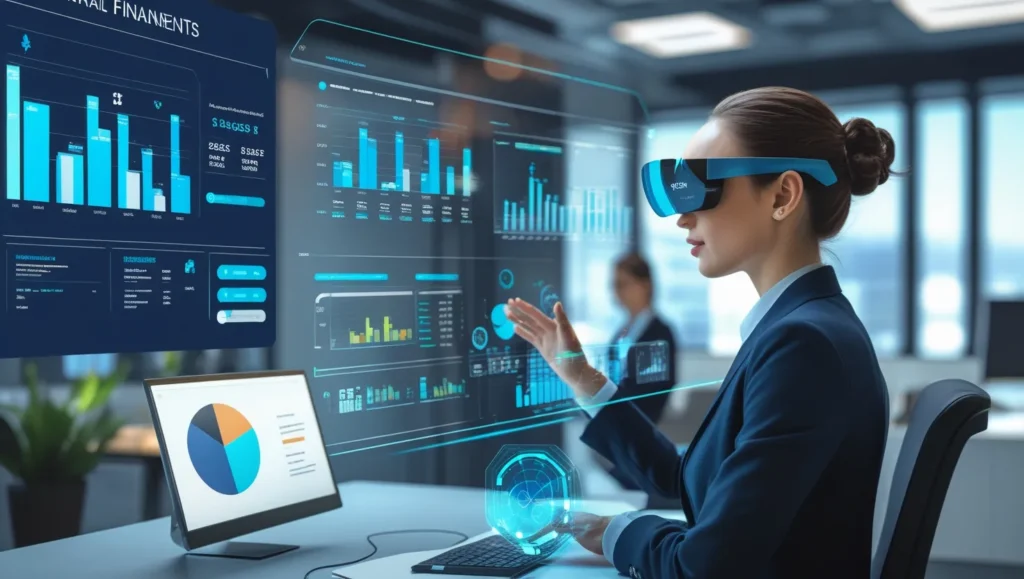
Why Virtual Reality Matters in 2025
From the silver screen to reality, Virtual Reality(VR) is now changing the world. It is transforming industries, entertainment, education, and how we connect. Immersive headsets make experiences feel real. Simulations bring ideas to life. AI-powered environments make them smarter. VR is no longer just for gamers. It is now a multi-billion-dollar global industry.
According to Statista, the VR market is expected to reach $22 billion by 2025, driven by gaming, training, healthcare, and remote collaboration. Whether you want to explore ancient civilizations, perform surgery without touching a patient, or attend a concert from your living room, VR makes it possible.
What is Virtual Reality?
Virtual Reality is a 3D world made by a computer. You can explore it like it is real. It is different from watching a video or scrolling a website. Virtual Reality uses your senses, sight, sound, and sometimes touch. That makes you feel like you are actually inside the digital world.
Differences in Extended Reality and Virtual Reality
Confusion Around XR Technologies
The world of Extended Reality (XR), an umbrella term that includes Virtual Reality (VR), Augmented Reality (AR), and Mixed Reality (MR) is growing fast. But for many people, these terms sound similar and confusing.
In Reality, each has unique characteristics, hardware requirements, and use cases. Knowing the difference will help you choose the right technology, whether you’re building apps, playing games, or training employees.
VR vs. AR vs. MR: Quick Comparison Table
| Technology | Environment | Interaction | Devices |
|---|
| VR | Fully simulated, replaces the real world | High immersion, virtual-only interactions | VR headsets (Oculus, HTC Vive, PS VR) |
| AR | Overlays digital objects onto the real world | Real-world view enhanced with graphics | AR glasses, smartphones |
| MR | Blends physical and digital worlds, allowing both to interact | Real and virtual elements coexist and respond to each other | HoloLens, Magic Leap |
History of Virtual Reality

VR’s journey spans almost two centuries of invention, imagination, and innovation.
Year Milestone
1838, Charles Wheatstone invented the stereoscope early 3D vision.
1935 Stanley Weinbaum publishes Pygmalion’s Spectacles, describing VR-like goggles.
1968 Ivan Sutherland created the “Sword of Damocles,” the first head-mounted display (HMD).
1984–1990s VPL Research develops Data Glove, EyePhone, and other VR tools.
1995 Nintendo launches Virtual Boy (commercial flop, but groundbreaking).
2012 Oculus Rift Kickstarter sparks VR revival.
2016–2019 HTC Vive, PlayStation VR, and Windows Mixed Reality hit the market.
2020s Standalone VR (Meta Quest series) and high-end MR (Apple Vision Pro) become mainstream.
See our History of Virtual Reality for a complete VR timeline with detailed events.
How Virtual Reality Works
VR works by tricking your brain into thinking digital images are real. It is done by feeding each eye a slightly different image (stereoscopic vision), tracking your movements in real time, and syncing audio, visuals, and sometimes touch Feedback to match your actions.
The magic happens when VR hardware and VR software work together just like a camera and film in traditional photography. Hardware handles input and output, while software creates and manages the virtual environment.
VR Hardware: The Physical Gateway to Virtual Worlds
You wear, hold, and interact with VR hardware to access a virtual environment. It displays the visuals, tracks movements, and creates sensory Feedback.
1. Head-Mounted Display (HMD)
- Purpose: The primary VR device is worn on the head that covers your eyes and often your ears.
- How it Works: Uses stereoscopic lenses to display slightly different images to each eye, creating 3D depth perception.
- Examples: Meta Quest 3, PlayStation VR2, HTC Vive XR Elite, Apple Vision Pro.
- Key Features:
- High Refresh Rates (90Hz–120Hz) to prevent motion sickness.
- Field of View (FOV) around 100–120 degrees for realism.
- Resolution (e.g., 2160×2160 per eye) for sharp visuals.
2. Motion Tracking Sensors
- Purpose: Detects the position and orientation of your head, hands, and sometimes your entire body.
- Types:
- Inside-Out Tracking – Uses cameras on the headset (Meta Quest series).
- Outside-In Tracking – Uses external base stations or sensors (HTC Vive, Valve Index).
- How it Works: Tracks movement in six degrees of freedom (6DoF) — forward/back, up/down, left/right, plus rotation on three axes.
3. Motion Controllers
- Purpose: Allow you to interact with virtual objects.
- Features:
- Buttons & Joysticks for commands.
- Trigger Sensors for grabbing and shooting actions.
- Haptic Feedback for touch sensation.
- Examples: Meta Touch Controllers, PlayStation VR Sense Controllers, Valve Index Controllers.
4. Haptic Feedback Devices
- Purpose: Simulate touch and physical sensations.
- Examples:
- VR gloves with pressure sensors.
- Full-body haptic suits for gaming and training.
- How it Works: Uses vibration motors, air pressure, or electrical stimulation to mimic textures, resistance, and impacts.
5. Audio Systems
- Purpose: Create realistic soundscapes.
- Types:
- Spatial Audio – Lets you hear sound from different directions.
- Built-in Headset Audio – Integrated in most premium VR headsets.
- Importance: Enhances immersion by matching sound to visual cues.
6. Optional VR Accessories
- VR treadmills for walking/running in place.
- Eye-tracking modules for foveated rendering (sharper where you look).
- Smell generators for multi-sensory VR.
VR Software: The Brain of the Virtual Experience
VR software builds, controls, and runs the virtual world you see and interact with. Without software, the hardware would be an expensive blindfold.
1. Game Engines
- Purpose: Create and render 3D environments.
- Popular VR Engines:
- Unity – Widely used for VR games and apps.
- Unreal Engine – Known for ultra-realistic graphics.
- Functions:
- Rendering visuals.
- Managing physics and object interactions.
- Handling lighting, textures, and animations.
2. VR Platforms & Stores
- Purpose: Distribute VR content and connect users.
- Examples:
- SteamVR – PC-based VR games and apps.
- Oculus Store – For Meta headsets.
- Viveport – VR subscription service.
- Functionality: Acts as both a library and a launcher for VR content.
3. Operating Systems & APIs
- Purpose: Connect VR hardware with software.
- Examples:
- OpenXR – Industry-standard API for cross-platform VR.
- Oculus SDK, SteamVR SDK – Manufacturer-specific toolkits.
4. Simulation & Interaction Software
- Purpose: Power VR training, simulations, and enterprise apps.
- Examples:
- VR surgical training tools.
- Architectural walkthrough software.
- Special Features:
- Real-world physics.
- Multi-user collaboration.
- AI-driven character behaviors.
How Hardware and Software Work Together
Here’s the step-by-step process of how VR works:
- Tracking Movement – Sensors detect your head, hand, and body motion.
- Processing Data – The VR software interprets your movements in real time.
- Rendering Frames – The game engine generates images from your point of view.
- Displaying the World – The headset shows the rendered frames at high speed.
- Syncing Sound & Touch – Audio and haptics match the visuals for realism.
Types of Virtual Reality
Virtual Reality (VR) is not a one-size-fits-all technology. It exists in several forms, each designed to meet specific needs, levels of immersion, and technical capabilities. Understanding these types of VR helps identify the right solution for different industries, applications, and user experiences.
1. Fully Immersive VR
Fully immersive VR is the most advanced and engaging form. It uses head-mounted displays (HMDs), motion tracking systems, and sometimes haptic feedback devices to completely transport users into a computer-generated world.
- Example: Gaming experiences like Half-Life: Alyx or simulation training for pilots.
- Key Features:
- 360° visuals with realistic depth and perspective
- Real-time tracking of head, hand, and body movements
- Physical interaction with the environment through controllers or gloves
- Use Cases: Flight simulators, military training, architectural visualization, and immersive storytelling.
2. Semi-Immersive VR
Semi-immersive VR provides a partial sense of presence in a virtual environment without entirely blocking out the real world. It usually involves large projection screens or desktop-based VR.
- Example: Interactive museum exhibits or educational simulations.
- Key Features:
- High-quality graphics displayed on flat or curved screens
- Limited head tracking compared to fully immersive VR
- Focused more on learning and professional training than entertainment
- Use Cases: Medical education, mechanical design visualization, and collaborative planning.
3. Non-Immersive VR
Non-immersive VR is the most accessible type and is often used without specialized headsets. It delivers a virtual experience through a standard computer or mobile screen.
- Example: 3D walkthroughs of real estate properties or virtual e-commerce product previews.
- Key Features:
- A virtual world visible on a monitor or mobile device
- Interaction via keyboard, mouse, or touchscreen
- No complete isolation from the real environment
- Use Cases: Online product demos, casual gaming, and training simulations on regular PCs.
4. Collaborative VR (Social VR)
Collaborative VR focuses on shared virtual spaces where multiple users can interact in real-time using avatars. This type is increasingly popular with the rise of the metaverse.
- Example: Platforms like VRChat or Meta Horizon Worlds.
- Key Features:
- Real-time communication and interaction
- Multi-user environments for work or play
- Voice chat, gestures, and shared activities
- Use Cases: Remote team collaboration, social networking, virtual conferences, and multiplayer gaming.
5. Augmented Virtuality (AV)
Augmented Virtuality is a blend of real-world elements into a predominantly virtual environment. It’s the opposite of AR (which overlays digital elements on Reality).
- Example: Inserting real-time video feeds into a VR training simulation.
- Key Features:
- Integration of real-world visuals within a VR experience
- Allows interaction between real and virtual objects
- Use Cases: Mixed media art installations, advanced simulation training, and hybrid virtual production.
Benefits of Virtual Reality
VR’s value lies in its realism, safety, and scalability.
1. Education & Training
- VR makes complex topics easier to grasp, from anatomy to physics.
- Example: A pilot can train in a VR cockpit before flying a real plane.
2. Healthcare
- VR therapy helps treat PTSD, phobias, and pain management.
- VR surgical simulations reduce errors in real operations.
3. Entertainment
- Immersive games, interactive films, and virtual concerts.
- Example: Beat Saber, a rhythm game, sold over 4 million copies.
4. Business & Collaboration
- Virtual offices for remote teams.
- VR product prototyping without physical models.
Applications of Virtual Reality (VR)
Virtual Reality (VR) is no longer limited to sci-fi fantasies or niche gaming setups—it has now entered almost every industry, reshaping how we learn, work, communicate, and even heal. By simulating realistic, immersive environments, VR enables users to interact with 3D worlds in ways once impossible.
Let’s explore how VR is being applied across various fields.
1. Gaming and Entertainment
Gaming is the birthplace of mainstream VR adoption. Platforms like Meta Quest, PlayStation VR, and HTC Vive have brought 360° immersive worlds to living rooms. Players can explore alien planets, race supercars, or battle enemies from their couch.
VR creates virtual concerts, interactive movies, and immersive theater experiences in entertainment. Imagine standing on stage with your favorite band or being part of a movie scene where the story changes based on your choices.
Examples:
- Beat Saber: Rhythm-based VR game
- Half-Life: Alyx: Cinematic, story-driven VR adventure
- MelodyVR: Virtual concert platform
2. Education and Training
VR has become a powerful learning tool, especially for experiential learning. Instead of reading about the solar system, students can walk through planets in 3D space. Medical students can practice surgeries in risk-free simulations.
Industries also use VR for corporate training—pilots practice flight simulations, factory workers learn machinery operations, and emergency responders train for disaster scenarios.
Examples:
- zSpace: STEM-based virtual learning
- Oxford Medical Simulation: Healthcare training
- Labster: VR science lab simulations
3. Healthcare and Therapy

In healthcare, Virtual Reality is used for surgical training, pain management, mental health therapy, and physical rehabilitation. For patients with anxiety or PTSD, VR-based exposure therapy allows gradual desensitization in a safe space.
Physical therapy programs use VR games to motivate movement and track progress. Surgeons use VR to plan complex operations by visualizing patient anatomy in 3D.
Examples:
- AppliedVR – Pain management solutions
- XRHealth – VR-based physical therapy
- Osso VR – Surgical training platform
4. Architecture and Real Estate
Architects and real estate agents use VR to offer virtual property tours. Buyers can walk through a house before it’s built, or explore different designs and layouts in real time.
Construction firms use VR to detect design flaws, visualize building plans, and improve collaboration between engineers and designers.
Examples:
- Matterport – 3D property scanning and VR tours
- Enscape – VR for architectural visualization
5. Tourism and Travel
VR allows travelers to visit destinations virtually before booking. It boosts tourism marketing by offering 360° previews of landmarks, hotels, and activities. Historical VR tours can also recreate lost monuments or ancient civilizations.
Examples:
- Google Earth VR – Explore the world in immersive 3D
- Ascape VR – Virtual travel experiences
6. Military and Defense
The military uses VR for combat simulations, vehicle operation training, and mission planning. These simulations provide realistic, high-pressure training without the risks of real-world drills.
VR scenarios can simulate urban warfare, aerial combat, or submarine missions, ensuring soldiers are prepared for various environments.
Examples:
- Bohemia Interactive Simulations – Military VR training tools
- VBS Blue IG – Immersive tactical training platform
7. Retail and E-commerce
Retailers are embracing VR to create virtual showrooms, letting customers try products before purchasing. Furniture stores, for example, allow users to visualize how a sofa fits into their living room. Fashion brands offer virtual fitting rooms to try on clothes without visiting a store.
Examples:
- IKEA Place – Visualize furniture at home
- Obsess – VR shopping experiences
8. Sports and Fitness
VR in sports is used for training, fan engagement, and virtual fitness classes. Athletes can practice techniques in simulated conditions. Fans can watch live games from a courtside seat through VR streaming.
In fitness, VR workout games like Supernatural turn exercise into a fun, interactive challenge.
Examples:
- STRIVR – Sports training VR
- Supernatural – VR fitness platform
9. Manufacturing and Industry
Factories use VR for equipment training, safety drills, and production planning. Engineers can simulate assembly processes to optimize workflow before launching production.
Examples:
- Siemens VR Training – Industrial workforce training
- EON Reality – VR for industrial simulations
10. Space Exploration
Agencies like NASA use VR to train astronauts for spacewalks, docking maneuvers, and planetary exploration. VR helps simulate zero-gravity conditions and alien landscapes for mission preparation.
Example:
- NASA’s Hybrid Reality Environment – Space mission training
VR is not just for gamers; it is a cross-industry innovation changing how we live, learn, and connect. From saving lives in healthcare to making travel accessible from home, the applications of VR are vast and rapidly expanding.
Top VR Devices & Platforms
Popular VR Headsets in 2025:
- Meta Quest 3 – Affordable standalone VR.
- Apple Vision Pro – Premium MR headset.
- HTC Vive XR Elite – High-end PC VR.
- PlayStation VR2 – Console-based VR.
Leading VR Platforms:
- SteamVR – PC-based VR games.
- Oculus Store – Meta’s VR app marketplace.
- Viveport – Subscription VR library.
Challenges & Limitations of Virtual Reality
- Cost Barrier – High-end devices cost $1,000+.
- Motion Sickness – Caused by a mismatch between movement and visuals.
- Content Gaps – Not all industries have mature VR experiences.
- Space Needs – Some VR setups require a dedicated room.
Future of Virtual Reality
Virtual Reality (VR) is no longer just an exciting novelty. It is rapidly becoming an integral part of industries ranging from gaming to medicine, education, manufacturing, and beyond. As technology evolves, its future promises even more immersive, interactive, and personalized experiences. The coming years will see VR transitioning from specialized use cases to mainstream daily applications.
1. Hardware Advancements
The future of Virtual Reality will be shaped heavily by next-generation hardware focusing on comfort, portability, and realism.
- Lightweight Headsets – Current VR devices can feel bulky during long sessions. Future designs will be ultra-light, with better weight distribution and ergonomic comfort for extended wear.
- Higher Resolution & Field of View (FOV) – Displays will offer 8K resolution per eye with minimal screen-door effect, making virtual scenes indistinguishable from real life.
- Wireless Freedom – Advances in Wi-Fi 7 and other high-speed wireless technologies will remove the need for cumbersome cables while maintaining low latency.
- Haptic Feedback & Full-Body Tracking – Gloves, suits, and wearable sensors will deliver touch sensations, texture simulation, and even temperature feedback, bringing virtual objects to life.
- Eye-Tracking Technology – Integrated foveated rendering will reduce GPU strain while enhancing realism by focusing rendering power where the eye is looking.
2. Software & Content Evolution
The success of VR’s future also depends on the software ecosystem and content quality.
- Photorealistic Graphics – Real-time rendering powered by AI-driven engines like Unreal Engine 5 will make virtual worlds almost indistinguishable from Reality.
- Persistent Virtual Worlds – The rise of the metaverse will enable shared, interconnected 3D spaces that persist even when users log out.
- AI-Powered Personalization – VR environments will adapt dynamically to users’ moods, preferences, and learning pace.
- Cross-Platform Integration – VR will seamlessly blend with AR (Augmented Reality) and MR (Mixed Reality), creating extended reality (XR) ecosystems.
- Cloud VR – High-quality VR experiences will stream directly from the cloud, removing the need for powerful local hardware.
3. Industry-Specific Transformations
In the next decade, VR will revolutionize multiple industries:
- Healthcare – Remote surgeries, mental health therapy, and advanced medical simulations will become more accurate and accessible.
- Education – Virtual classrooms will replace textbooks with hands-on, immersive learning experiences that improve retention.
- Work & Collaboration – Virtual offices will allow teams from around the globe to collaborate as if they’re in the same room.
- Retail & Real Estate – Customers will virtually walk through products or properties before purchasing.
- Defense & Training – Military and industrial training will use realistic VR simulations for high-risk environments without danger.
4. VR in the Metaverse
The metaverse will be a significant driving force for VR adoption. With platforms like Meta’s Horizon Worlds, Microsoft Mesh, and Decentral and users will
- Socialize in immersive 3D environments.
- Attend virtual concerts, exhibitions, and conferences.
- Own and trade virtual assets through blockchain technology.
5. Challenges to Overcome
While the future is promising, there are hurdles to address:
- Motion Sickness – Improved frame rates and motion tracking will reduce discomfort.
- Affordability – Mass adoption will require more budget-friendly VR setups.
- Content Availability – Diverse, high-quality VR applications must grow to attract mainstream audiences.
- Privacy & Security – Protecting user data in immersive environments will be crucial.
6. Predictions for the Next 10 Years
By 2035, experts predict:
- Virtual Reality will be as common as smartphones.
- Many jobs will exist entirely in virtual environments.
- AI companions in VR will become indistinguishable from humans.
- VR and brain-computer interfaces will merge, allowing direct interaction without controllers.
In short, the future of VR is heading toward hyper-realistic, lightweight, and socially connected experiences that will touch nearly every aspect of our lives. As hardware and software evolve, the line between the real and virtual worlds will blur, creating limitless opportunities.
Conclusion
Virtual Reality is no longer a futuristic fantasy. It is an evolving technology reshaping how we work, play, and learn. VR has proven its value across industries, from immersive gaming worlds to life-saving medical simulations.
As hardware becomes lighter and more affordable and software grows more intuitive, VR will continue to bridge the gap between the digital and physical worlds. Its potential is enormous, from redefining education to revolutionizing how we collaborate remotely. Businesses, educators, and creators who embrace VR today will be ahead in the experience-driven future of tomorrow.
FAQs
What are the benefits of using VR?
VR offers numerous benefits, including:
- Immersive Learning – Helps people understand complex concepts through realistic simulations.
- Safe Training Environments – Allows high-risk training without danger (e.g., pilots, surgeons).
- Enhanced Engagement – Increases user attention and retention compared to traditional methods.
- Remote Collaboration – Teams can meet and interact in virtual spaces.
- Entertainment and Creativity open new gaming, storytelling, and art possibilities.
How can VR be used to create a realistic environment?
VR creates realistic environments using:
- 3D Modeling & Animation – Developers design detailed virtual worlds with textures, lighting, and physics.
- Motion Tracking – Sensors and cameras track head and body movements for accurate positioning.
- Haptic Feedback – Controllers and gloves simulate touch sensations.
- Spatial Audio – Surround sound adds depth, helping the brain believe it’s in the scene.
What is Virtual Reality (VR)?
Virtual Reality (VR) is a computer-generated simulation that immerses users in an artificial environment. With headsets, controllers, and sometimes haptic devices, VR allows users to explore and interact with 3D worlds as if they were physically present.
What is Virtual Reality & how does it work?
Virtual Reality is a technology that replaces the real-world view with a simulated 3D environment.
- Hardware: Includes VR headsets (like Meta Quest or HTC Vive), sensors, and controllers to detect movements.
- Software: Generates interactive 3D worlds in real time, responding to user input and adjusting the scene accordingly.
- Combining visual immersion, sound, and motion tracking tricks the brain into experiencing the digital environment as real.
Did you know about virtual Reality in 2016? Yes! 2016 was considered a landmark year for VR. It marked the release of major consumer VR headsets like Oculus Rift, HTC Vive, and PlayStation VR. Many tech companies jumped into VR development, and the gaming industry became one of the first to fully embrace the technology. It was also the year when public awareness of VR skyrocketed, setting the stage for its current growth.


